Introducing The SAE 2HP-D Dual Mono Power Amp
“One To Rule Them All”. Doug Blackburn, Widescreen Review 2017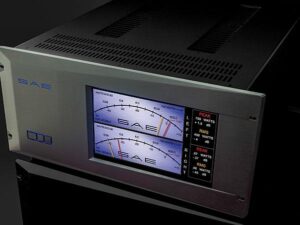
The SAE 2HP-D ($24,000 MSRP) is the most Modern, Powerful, Fastest, Quietest, Transparent, and Reliable Power Amplifier available today. It is CLASS A Rated in the Stereophile Recommended Components List since 2017 and features 600 Watts Per Channel x 2 at 8 ohms, 1200 Watts Per Channel x 2 at 4/2 Ohms, FTC Power Rule Rated.
The THD + N @ Rated Power is <0.005% at -128 dB SNR. It operates in Class A/B, Fully Balanced From Input to Output. It is Designed and Manufactured in the U.S.A. and comes with a 7 Year Warranty. This is the story of how it came to be.
Fifty years ago, SAE’s first component, the MKII stereo amplifier, rearranged the amplifier world’s power structure. Per Stereophile, a pair of MKll’s had sweeter highs and dramatically improved bass when compared to the industry’s then acknowledged “best.” Their latest, the dual-mono 2HP-D, repeats the exercise. If a gold medal were available in the category, I would predict victory.
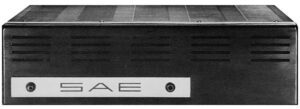 SAE (Scientific Audio Electronics) first commercial product was the MK II, a stereo amplifier capable of 60 Watts RMS per channel introduced in 1967. When it was reviewed by J. Gordon Holt, Stereophile’s editor-in-chief, he wrote, “under most conditions, (the SAE MK II) is the best-sounding solid-state amplifier we have heard to date.” This was praise, indeed, for any non-tubed amplifier during that day and set the stage for a series of ground-breaking SAE amplifiers designed by such industry luminaries as Ed Miller, Morris Kessler, James Bongiorno and Jerry Curtis.
SAE (Scientific Audio Electronics) first commercial product was the MK II, a stereo amplifier capable of 60 Watts RMS per channel introduced in 1967. When it was reviewed by J. Gordon Holt, Stereophile’s editor-in-chief, he wrote, “under most conditions, (the SAE MK II) is the best-sounding solid-state amplifier we have heard to date.” This was praise, indeed, for any non-tubed amplifier during that day and set the stage for a series of ground-breaking SAE amplifiers designed by such industry luminaries as Ed Miller, Morris Kessler, James Bongiorno and Jerry Curtis.
Thus, expectations for our newest design, the SAE 2HP, were set sky-high. We needed to insure that our new amp would never be the limiting factor in any audio system no matter how grand. Regardless of the cost, the 2HP needed to be more powerful, quieter, faster, more transparent and more reliable than any available.
To accomplish this goal, Morris Kessler, SAE’s co-founder and chief engineer, took an advanced topology pioneered by Bongiorno and enlisted Curtis, one of Bongiorno’s colleagues and an early SAE engineer, to polish the gem. The topology was a take on the balanced-differential design that has become common for advanced high-performance amps where each channel is comprised of two amplifiers driven in bridge mode. When properly executed, bridged amplifiers power and speed (slew rate) increase and noise is cut in half.
Bongiorno’s improvement, now included in all current SAE amplifier designs, retains the push-pull output stage, but is now run from only a single 4-quadrant input. The use of only a single input stage improves performance. Noise is again cut in half and slew rate improved. Complications do ensue but they were solved by using current feedback instead of the more common voltage feedback, dual DC Servos to maintain low-frequency response and impeccable board lay-out. With the 2HP, Curtis worked to insure each amplifier was not only electrically balanced and mirror imaged, it was also physically balanced around the fulcrum of the central ground point. Every improvement he wrought, lowered distortion and noise.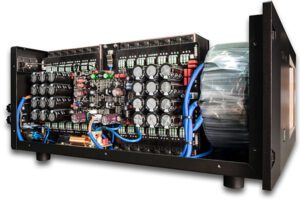
One Channel of the Dual-Mono SAE 2HP Amplifier
Each channel consists of a huge, custom-wound toroidal transformer,
2 amplifier output stages each with 7 output devices (14 total) and 93,600 µF of filter capacitors. Jerry Curtis immaculate board layout is in full evidence. Each half of the main board is not only electrically balanced, it is also a mirror-image of the other half.
Board layout itself is not the sole factor in the prodigious capability of the SAE 2HP-D. Kessler, who has been designing solid-state amplifiers for over 50 years, specified the use of innovative ThermalTrak output devices. With ThermalTrak, the temperature sensor required for the amps’ bias tracking is actually built into the same package as the output transistor. This allows accurate real-time bias and performance optimization. Whether the amplifier is just turned on or has been operating for hours, playing pianississimo or triple forte, the 2HP-D is always operating at its optimum.
The prodigious power output of the SAE 2HP requires a prodigious power supply. Or in this case, two supplies as the 2HP is a true dual-mono design with each channel completely independent. From the rear panel one can easily discern the amplifier has two line-cords, two power switches and for maximum power, each should be connected to its own 20 amp AC circuit. Only the front-panel power switch and rear-panel trigger input join the two.
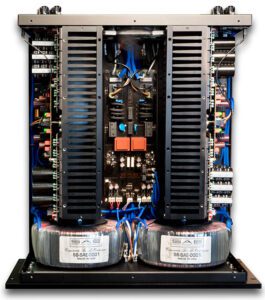 Inside, each channel has a custom-wound toroidal transformer with hand-selected low-noise core and independent secondary outputs with one for each half of the two bridged output stages feeding independent rectifiers and a bank of 12 3900 µF filter capacitors for total power supply storage of 93,600 µF per channel. Further, the capacitors are located as close as possible to the amplifier outputs to reduce power supply resistance and further improve performance.
Inside, each channel has a custom-wound toroidal transformer with hand-selected low-noise core and independent secondary outputs with one for each half of the two bridged output stages feeding independent rectifiers and a bank of 12 3900 µF filter capacitors for total power supply storage of 93,600 µF per channel. Further, the capacitors are located as close as possible to the amplifier outputs to reduce power supply resistance and further improve performance.
With 28 output transistors (14 per channel) the amplifier can deliver current into any load down to and including two ohms and the amplifier is designed with complete but unobtrusive protection circuitry. There is no current limiting in the 2HP and the audio signal never passes through any protection circuits. All protection is optically coupled and outside the signal path. Should a problem occur, the power supply is immediately disconnected and a timer starts. Every 10 seconds, the problem is reevaluated. When safe operation can be restored, the amplifier resumes play automatically.
Any amplifier as powerful as the 2HP must be designed to dissipate heat effectively and silently. Under virtually all operating conditions, convection cooling with air passing unassisted through the massive heat sinks is sufficient to maintain proper operation. In those rare situations where long-term high power operation is required, the user can engage an auxiliary cooling fan to assist maintaining proper thermal equilibrium.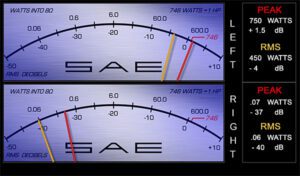
Virtual VU Meters
SAE not only set amplifier performance standards, our innovative use of rackmount chassis and massive VU meters also made the brand a design leader. For the 2HP-D, Kessler and company developed “Virtual VU Meters, LCD displays where moving electrons display power output. With neither inertia nor mass, the meters accurately display peak and average power simultaneously . Should the user so choose, the meters can be be switched to a dual-channel frequency spectrum display.
 The SAE 2HP-D received a “CLASS A” rating from the Stereophile Recommended List in their March 2017 issue and is still listed today. Its the “best of the best”. Full specifications can be found here.
The SAE 2HP-D received a “CLASS A” rating from the Stereophile Recommended List in their March 2017 issue and is still listed today. Its the “best of the best”. Full specifications can be found here.
Interested parties should contact Bob Rapoport at his office in Gulfport, FL, [email protected] or 727-580-4393. I’m looking for qualified dealers around the world.

